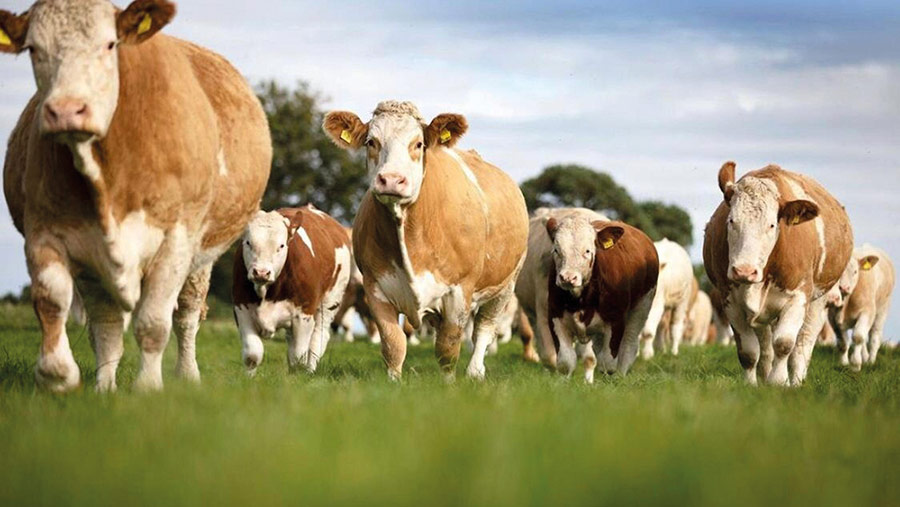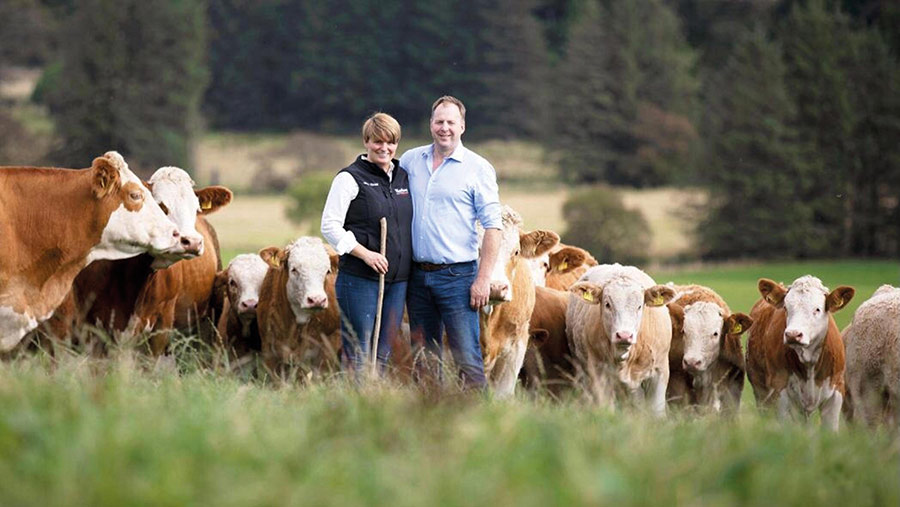How the Islavale Simmental herd manages 15% twins
 © Catherine MacGregor
© Catherine MacGregor Close attention to twin-bearing cows and milky, prolific genetics is helping a Scottish breeder regularly rear more than 100% calves to cows bulled.
The Islavale herd of Berryleys Farm, near Grange, Keith, is run as a partnership by Stewart Stronach, partner Fiona, his parents, Stewart and Hazel, and his son, Michael.
Like many Simmental herds, the Islavale herd experiences a high twinning rate most years.
The Stronachs participated in the Livestock Health Scotland and Scottish Agricultural College Live Calf Project, which looked at calf output in 2018 and 2019 on mainly commercial herds.
The overall average of the study was a twinning rate of 4%.
The herd averages a 12-15% twinning rate.
Below, Mr Stronach details some key factors that help the farm manage twins each year.
See also: Why Angus are earning an integrated finisher more than Blues
Farm facts
- 200 suckler cows, of which 150 registered pedigree under Islavale herd
- All cows bred to Simmental sires
- Split-block calving
- 250 Texel-cross ewes put to Texel rams
- 303ha (750 acres) mainly less favoured area ground
- Growing 60ha (148 acres) of malting barley and 242ha (597 acres) of silage and pasture
- Farm includes three holdings: Berryleys, Maisley and Mid Paithnick
1. Pregnancy diagnosis
Cattle are scanned for calves within six weeks of the bulling period ending, which is in September for the spring calvers.
This identifies the vast majority of twins and enables a close eye to be kept on them, with preferential grazing and earlier housing if required, explains Mr Stronach.
2. Separate group
Twins are typically housed together with older cows, thinner cows and some in-calf heifers.
This usually results in a group of 28-30 cows for each calving block, which are housed and fed separately all winter.
This group is housed at Mid Paithnick, the adjacent farm that the Stronachs own up the road from Berryleys.
All cows return home to Maisley a month prior to calving.
The twin group, including the thin cows and heifers, remains together at turnout, runs with one bull for natural service (as opposed to a cycle of AI) and remains as a group until weaning.
This allows priority grazing, extra barley and mineral supplementation to be provided to the group, as required.
3. Feed access and energy
All cows are fed a total mixed ration (TMR) through a feeder wagon of home-grown forage – barley wholecrop, grass silage, bruised barley, barley straw and minerals.
Cows are rationed by Norvite and the farm’s feeding programme is supported by feed adviser Iain MacDonald.
Wholecrop and grass silage is analysed, and minerals, energy and protein are balanced accordingly.
A standard cow is rationed at 12kg/day dry matter (DM) (about 36kg freshweight at 33% DM) and 8 litres of milk post calving at 125MJ/day.
An 800kg cow eats 12kg/day DM or more, so extra straw is added to the TMR.
The Stronachs supply cows with about 100MJ of energy/day in late gestation and twin-bearing cows are given 15-20MJ/day more on a flat rate.
The extra energy the twin group needs is supplied by feeding more TMR on an ad-lib basis.
The group is fed in the morning and feed is pushed up in the bunker in the afternoon and evening.
The twins also get about 0.5kg-1kg a head a day extra barley and blend (beet pulp, distillers and cold-pressed rapeseed).
This system allows the cows to choose when to feed.
In contrast, the other groups are rationed and given a daily ration and straw at morning feeding time.

Stewart Stronach and partner Hazel at Berryleys farm © Catherine MacGregor
This helps twin-bearing cows and thin cows calve at a condition score of three, so they can calve unassisted. Cows can choose to eat as they need.
Another important factor is feed space, explains Mr Stronach.
Feeding ad-lib at a wide feed bunk means 70% of cows can access feed at any one time, but only four might come and eat when the feed is delivered each morning, minimising bullying and maximising intakes.
The ad-lib ration contains a good-quality grass silage cut.
Last year, silage was cut in mid-to-late June and analysed at 69-70 digestibility value, 11.1-11.2ME, 25-27% DM and 10.2-10.4% crude protein.
4. Minerals
Winter mineral supplementation starts with a standard Norvite powdered mineral for beef cows, which the Stronachs feed at about 130-150g a head a day in the TMR.
The herd then gets a bespoke mineral made up to the farm’s forage requirements containing a luxury level of vitamin E (4,000 international units a kilogramme) and magnesium at 20% inclusion from six weeks pre-calving.
Among other things, magnesium helps muscle tone and calving, while vitamin E, with selenium, helps support calf vigour and immunity through improved colostrum quality.
Health plan
- Bovine viral diarrhoea (BVD) accredited since 2008 and using one-shot vaccine
- Herd testing for infectious bovine rhinotracheitis (IBR)
- All females vaccinated against IBR
- Testing for Johne’s – status is level-one risk since 2008
- Sale animals are semen-tested and IBR-tested (but not vaccinated)
After calving, the cows either go back on to a standard beef mineral or are turned outside with mineral buckets to address any deficiencies at pasture and reduce the risk of staggers.
The twin group also gets a bulling mineral mixed into a bruised barley and blend (16% crude protein), fed in hoppers. This increases the plane of nutrition and aid conception rates.
The calves are allowed to pick at this as a creep feed.
5. Stockmanship
The twin group is housed at one end of a shed directly underneath one of four cameras (two fixed, two remote controlled).
Because the herd’s genetics are so valuable, Mr Stronach will calve the majority of cows with an easy pull. With twins, the farm has found the first one is often coming backwards.
Caesareans are very few and far between on the farm, with one or two needed every five years on average.
“I check the calving cameras every two-to-three hours during calving time,” he says.
“Some cows can calve twins and suckle them on their own, but we do watch them closely. “If nothing comes within half an hour of the onset of calving, we check to see if they are front feet or not.
“As soon as we see back feet, we start to assist them. Once the first one is out, we then pull out the second.”
Most cows cope with twins. Sometimes a calf is fostered on to a cow if a calf is lost and, occasionally, the freemartin is sold to give the other twin, a purebred bull calf, the best chance. Twins can go on to sell as high EBV bulls at Stirling.
The calving shed has individual pens with self-locking yokes to aid management and help the new calves suckle. Cows are only penned to calve if necessary.
Twins are penned up with the cow for four days or so, until the dam has bonded with both calves, and most single outfits go out after 24 hours, weather permitting.
6. Genetics
The herd selects from easy-calving and milky lines. This means that some cows will calve twins unassisted and then suckle them on their own.
This is important, because with so many twins in the herd, there aren’t always cows to foster on to, so they stay with the dam until weaning. However, Mr Stronach says they have never bred for a high twinning rate.
“The Simmental breed is known for being milky and prolific,” he says. “We have never bred from heifers that were twins or used bulls that were twins, it is just part of having Simmentals.
“We tend to get more twins in the spring block group, which might be because they are bulling in summer at grass and it is a more natural system.”
Mr Stronach says three years of classification scoring has helped improve and monitor cow type and udder and teat placement.
The final score draws on body conformation (25%), beef character (25%), legs and feet (30%) and mammary system (20%).
More than 50 of the cows have been classed as excellent and 95% of the pure cows are very good or better.
Islavale herd system
Breeding
- 100 cows are in a spring-calving block (March to May) and 100 calve in an autumn-calving block (October to December).
- Both blocks last three cycles (about nine weeks).
- There are 50 non-pedigree cows on the farm. These cows are quite often used to carry embryos. All cows are sired by Simmentals.
- A round of artificial insemination is undertaken on 60-70 females in each block and sweeper bulls are used thereafter.
- Elite females in both calving blocks are flushed for multiple ovulation embryo transfer. There were four autumn calvers flushed in January.
- Spring-born heifer calves calve in the autumn herd. Autumn-born heifers calve in the spring block at 30 months old.
- 18-20% of the heifers are brought into each herd annually to maintain genetic gain.
Weaning
- Autumn-born calves are usually weaned in late August and cows are housed shortly afterwards. Bulls are creep-fed to minimise growth check.
- Spring calves are weaned in September/October and, if the weather permits, are grazed on barley stubbles until the weather deteriorates and they are then housed.
Wintering
- The farm budgets on a 200-day winter each year.
- The majority of the cows are wintered on straw in sheds. Younger, single-bearing cows in good condition are outwintered each year. Forty autumn calvers this year were outside on stubbles with straw, silage and minerals.
- A long winter requires a bulky silage cut, but the quality of silage is usually still about 11% crude protein and metabolizable energy due to clover content.
Rotation
- Old leys are silaged and then direct drilled with kale/fodder rape as a wintering crop for some of the fittest cows. Barley then follows, undersown with ryegrass, which is wholecropped before the field returns to grass the following year.
- About 60ha (148 acres) of barley is grown each year and about 15ha (37 acres) is reseeded each year.
